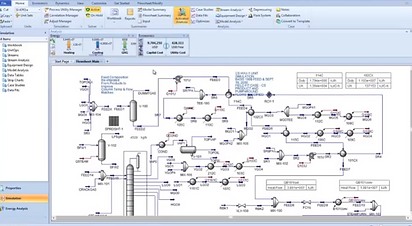


Energy Intensity
Energy usage in process facilities accounts for a significant portion of the operating costs. Also, energy deficiency is a major contributor to CO₂, SOx, NOx and other GHG emissions through the use of fossil fuel-based power and heating/cooling medium. We offer leading energy optimization throughout the process and utility systems utilizing state-of-the-art Aspen One technology based on EU-BAT directives to identify environmental and operating improvements within the acceptable cost-energy balance.

Aspen Energy Analyzer
AstraConcepts utilizes Aspen Energy Analyzer and Activated Exchanger Design & Rating to maximize heat recovery by optimizing exchangers and fired heaters configuration, minimize fouling and enhancing cleaning in preheat trains. Aspen Energy Analyzer™ optimizes heat integration using pinch techniques in process units.
Aspen Energy Analyzer is fully integrated with Aspen HYSYS through the Activated Energy Analysis, providing full information of energy consumption, GHG emissions and cost data.
Key Benefits
-
Design of a plant-wide and optimized energy and utility systems, minimizing steam, fuel and power systems costs.
-
Reduction of greenhouse gas emissions (GHG) and water consumption.
Facility-Wide Applications
Refinery
-
Gas Plants
-
Hydrocrackers
-
Hydrotreaters
-
Alkylation
-
Platformers
-
Isomerization
Gas Plants
-
LNG Plants
-
Sour Water Strippers
-
Gas Compressors
-
Fuel Gas Network
-
Condensate Strippers
-
Propane & MCR
BAT Energy & CO₂ Indices
EII and CEI Benchmarking
AstraConcepts utilizes Aspen HYSYS to benchmark your plant against best available technology (BAT) configurations utilizing the following tools:
-
Activated Energy Analysis
-
Aspen Energy Analyzer™
-
Aspen Utilities Planner™
Energy consumption (BAT-E) and carbon emission (BAT-C) for various Refinery Configurations at various Nelson Complexity Indices (NCI) is calculated to identify best available technology (BAT) gap and recommendations.
The BAT-E and BAT-C values represent the benchmark against which existing configuration and future configurations are evaluated providing a meaningful Energy Intensity Index (BAT-EII) and Carbon Intensity Index (BAT-CEI).
CARBON Intensity Calculations utilizes both CO₂ emissions based on energy deficiency as well as CO₂ consumption, capturing and generation in process and utility systems.
Aspen One Energy Design
Aspen One is process simulation platform for driving excellence in hydrocarbon facilities and it provides comprehensive features for integrated refinery operation (ISBL and OSBL).
Aspen One ensures that process utility demands are met. Impeded tools are utilized to support design decisions when analyzing the energy and cost balance of the proposed configurations.
The Aspen One tools provide a full spectrum of energy design optimization for refinery wide integration.
-
Activated Energy Analysis
-
Activated Exchanger Design & Rating
-
Aspen Air Cooled Exchanger™
-
Aspen Fired Heater®
-
Aspen HTFS® Research Network™
-
Aspen Plate Exchanger™
-
Aspen Plate Fin Exchanger™
-
Aspen Shell & Tube Exchanger™
-
Aspen Shell & Tube Mechanical™
-
Aspen Coil Wound Exchanger
-
Aspen Energy Analyzer™
-
Aspen Utilities Planner™